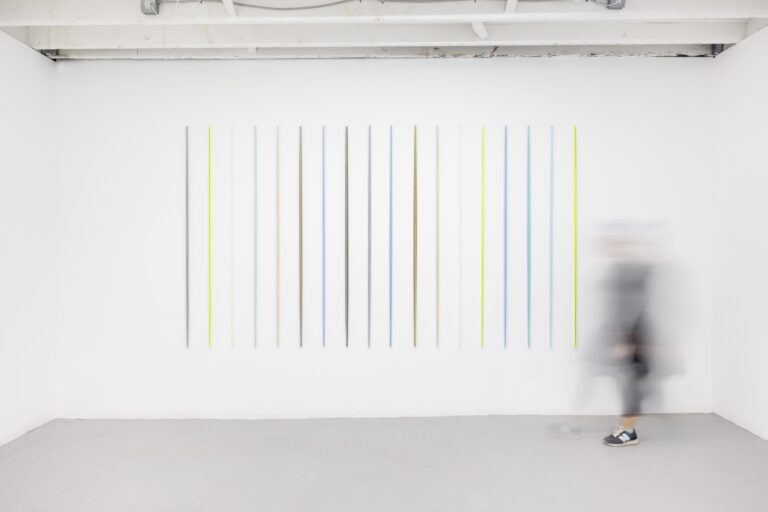
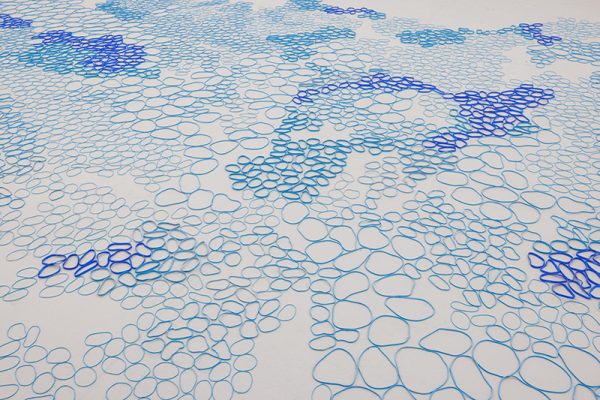
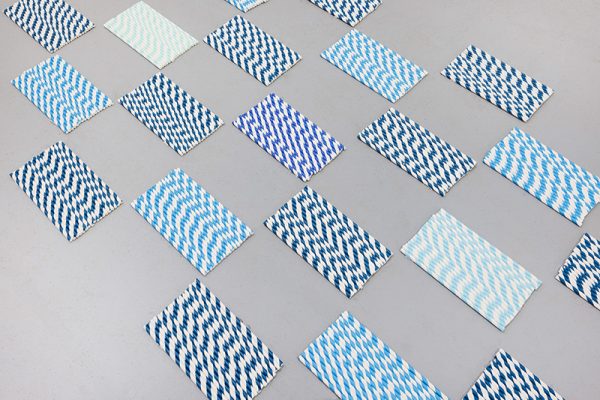
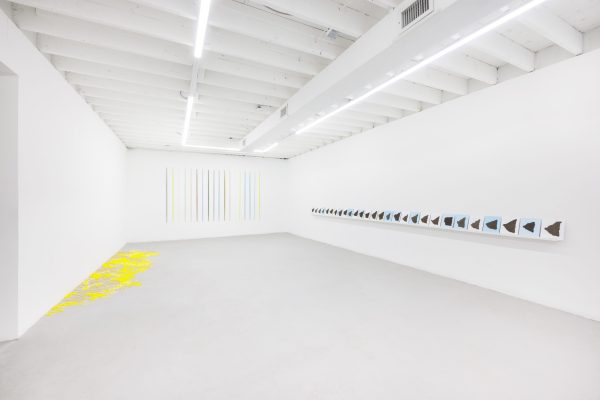
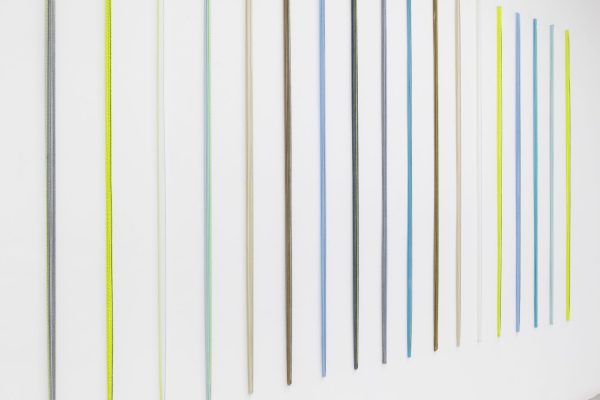
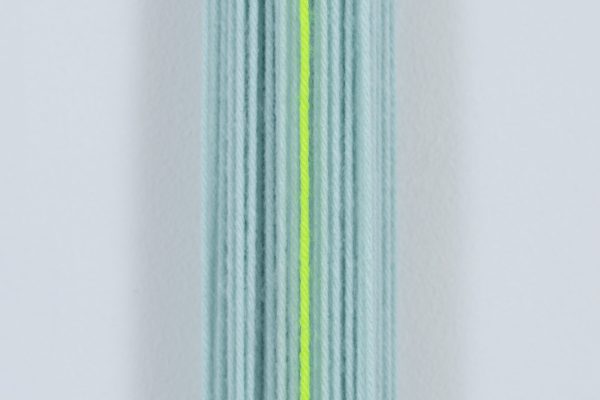
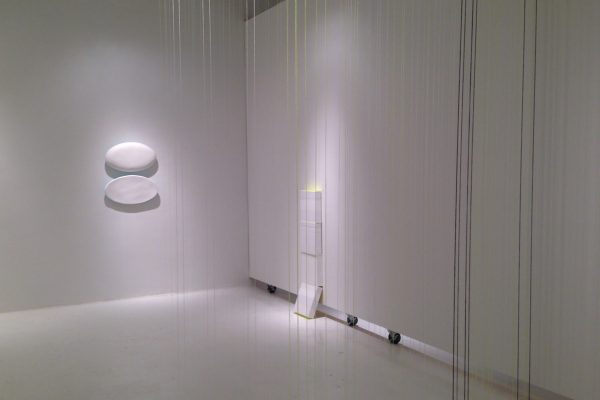
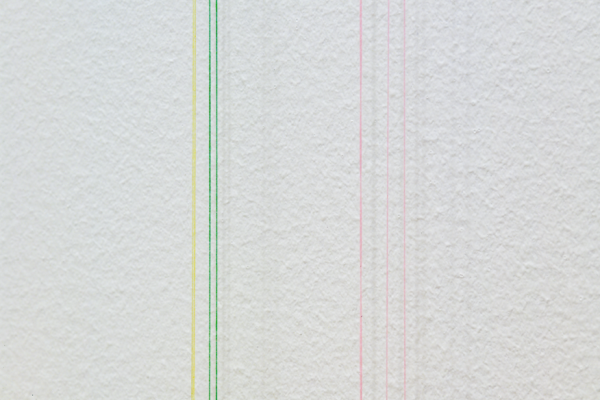
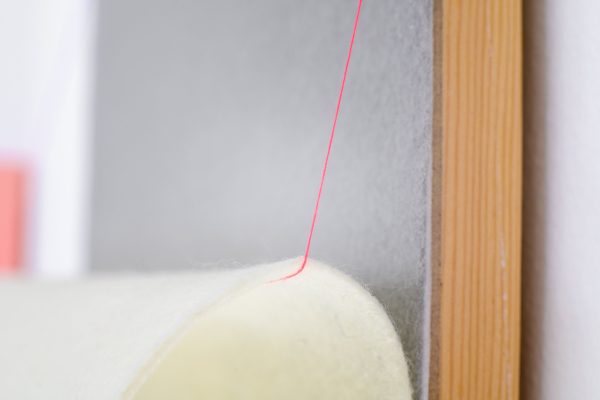
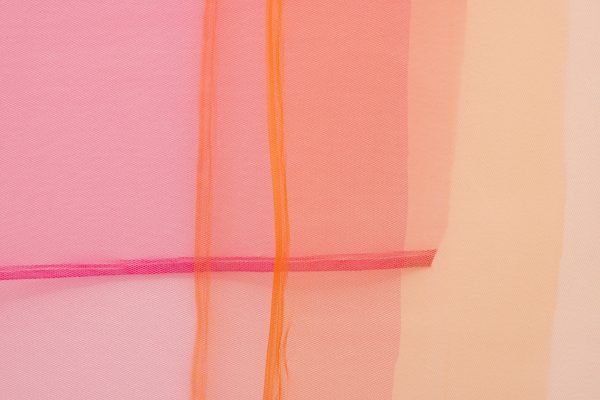

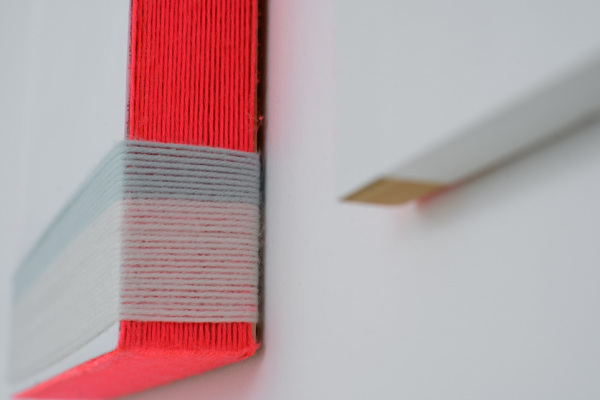

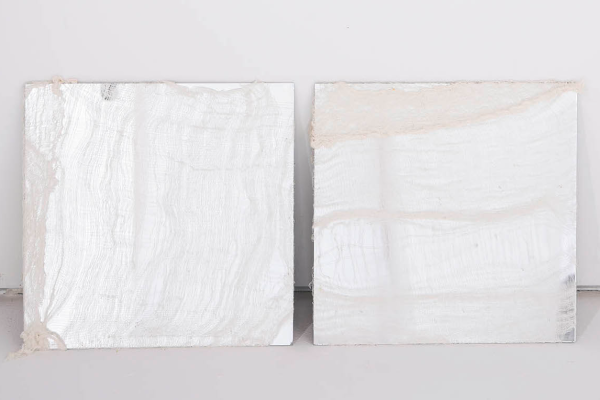













Born in Nicaragua, based in Miami.
Master of Fine Arts, Virginia Commonwealth University, Richmond, VA, 1996
Bachelor of Fine Arts, Florida International University, Miami, FL, 1993
Perez Art Museum Miami, Florida
Frost Art Museum, Miami, FL
Hirshhorn Museum and Sculpture Garden, Smithsonian Institution, Washington, DC
National Museum of Women in the Arts, Washington, DC
Weatherspoon Museum, Greensboro, NC
Brown University’s David Winton Bell Gallery, Providence, RI
Fundación Ortiz-Gurdián, Nicaragua
Fundación Rozas-Botrán, Guatemala
Ellies Creator’s Award, Oolites Arts, Miami, Fl, 2025
MIA Miami Individual Artists Grant, Miami-Dade County Department of Cultural Affairs, Miami, FL, 2024-25
Corral & Cathers Professional Artist Fund Grant, Coral Gables Community Foundation, Coral Gables, FL, 2024-2025
MIA Miami Individual Artists Grant, Miami-Dade County Department of Cultural Affairs, Miami, FL, 2023-24
MIA Miami Individual Artists Grant, Miami-Dade County Department of Cultural Affairs, Miami, FL, 2022-23
Artpace, San Antonio, TX, 2025
Dimensions Variable, Miami, FL, 2022-present
UNTITLED Art Fair, Patrick Heide Contemporary Art, (London, UK), Miami, FL, 2023
UNTITLED Art Fair, Patrick Heide Contemporary Art, (London, UK), Miami, FL, 2022
TOGETHER, LaPera Projects, (NY), Seven Seas Motel, Miami, FL, 2021
ART LIMA, Aninat Gallery, (Chile), Lima, Perú, 2018
UNTITLED Art Fair, Aninat Gallery, (Chile), Miami, FL, 2017
ARCO Art Fair, Isabel Aninat Gallery, (Chile), Madrid, Spain, 2017
UNTITLED Art Fair, Isabel Aninat Gallery, (Chile), Miami, FL, 2016
UNTITLED Art Fair, Y Gallery, (NY), Miami, FL, 2015
“The emptiness that is not”, Mahara_and_co Art Gallery, Miami, Fl, 2024 (two-person show)
“Transient Territories”, Patrick Heide Contemporary, London, UK, 2023 (two-person show)
“Still”, Frost Art Museum, Miami, FL, 2014
“Carving Silence”, Alliance Français, Managua, Nicaragua, 2009
Lehman College Art Gallery, New York, NY, 2005
Fusebox Gallery, Washington, DC, 2003
“Maquettes”, Baumgartner Galleries, New York, NY, 1999
Fredric Snitzer Gallery, Miami, FL, 1998
Arlington Arts Center, Arlington, VA, 1997
Tuttle Gallery, McDonough, MD, 1996-1997
Anderson Gallery, Richmond, VA, 1996
“Nuestro Vaivén/Our Sway”, The Ringling Museum, Sarasota, Fl, 2025
“Outside of the frame”, Edgezones, Miami, FL 2025”
“Under Pressure”/”Bajo Presión”, La Poli/Gráfica Triennial, Instituto de Cultura Puertorriqueña, San Juan, PR, 2024
“Aim Biennial”, Miami, Fl, 2023
“You are here”, Dimensions Variable, Miami, Fl, 2023
“Small things that seem eternal”, ArtSpace 305, Miami, Fl, 2023
“The BluPrnt”, The Bridge Red space, Miami, FL, 2023
“Placebo”, I.D. Art Lab, Miami, Fl, 2022
“The world is a handkerchief”, Coral Gables Museum, Miami, Fl, 2023. Traveled from London Print Studio Gallery, London, UK, 2019, Elizabeth Foundation for the Arts, Ny, 2020, Proyecto’Ace, Buenos Aires, Argentina, 2022.
“Artists draw their studios”, Art and Culture Center, Hollywood, Fl, 2019
“Black/White + Friends”, Galerie Burster, Berlin, Germany, 2017
“The Ambiguous Lightness of Being”, Diana Lowenstein Gallery, Miami, 2016
“Illuminations”, Miami Biennale, Miami, FL, 2015-16
“Caribbean Crossroads”, Perez Art Museum, Miami, FL, 2015
“Caribbean Crossroads”, Museo del Barrio, New York, NY, 2014
“One year and crossing”, Tub Gallery, Miami, FL, 2014
“9th Nicaragua Biennial”, Managua, Nicaragua, 2014
Bruno Marina Gallery, Brooklyn, NY, 2013
“S- Files”, Museo de Arte de Puerto Rico, San Juan, PR, 2006
“Extreme Abstraction”, Albright-Knox Gallery, Buffalo, NY, 2005
“S- Files”, Museo del Barrio, New York, NY, 2005
“Transitory Patterns”, National Museum of Women in the Arts, Washington, DC (travel to 5 Florida Museums through 2007), 2004
“OPEN HOUSE: Working in Brooklyn”, Brooklyn Museum, NY (cat), 2004
“The Americas,” Galeria Galou, Brooklyn, NY, 2004
“5th Caribbean Biennial”, Museo de Arte Moderna, Santo Domingo, Dominican Republic, 2003
“Puddle Wonderful”, Artemis Greenberg Van Doren Gallery, NY, NY, 2003
“Before Reflection Begins”, DW Bell Gallery, Brown University, Providence, RI (cat), 2002
“3rd Nicaragua Biennial”, Managua, Nicaragua (cat), 2001
“Remnant”, The Bertha and Karl Leubsdorf Gallery at Hunter College, NY, NY (cat), 2001
Fusebox Gallery, Washington, DC, 2000
”The Big Picture”, Contemporary Museum, Baltimore, MD, 1998
Corcoran Gallery of Arts, Washington, DC, 1998
“Departing Perspectives”, Fredric Snitzer Gallery, Espirito Santo Bank Project, Miami, FL, 1998
“From Here”, Baumgartner Galleries, Washington, DC, 1997-1998
Residency, Maryland Art Place, Baltimore, MD, 1997
On “Still”, Solo Exhibition at Frost Art Musem, Miami, 2014
Klaudio Rodriguez, curator Frost Art Museum
“Still” presents a series of new works by Marisa Tellería in which perception and aesthesis are not only the key to understanding, but the essential subject of the artworks. These original groups of works, which mark a new formalistic approach, were created specifically for the space they inhabit, and set the course for many of her subsequent investigation
The seed for these works were planted several years ago after a turbulent period in the artist’s life, when she found herself at a crossroads, ultimately questioning and reassessing the nature of her practice. During a period of self-reflection, she found the need to unload, unburden and simplify herself, and her work, both physically and spiritually. She was compelled to be still, to get rid of all the noise around her, to once again be one-on-one with the work. This decision led her to turn away from the creation of concrete art objects. The new works have dematerialized and become transitory, they are ephemeral and short-lived. The works turn towards sensory perception itself. Tellería constructs these perception-altering structures whose form and presence waver and feint until your eyes and the rest of you become destabilized. She deconstructs the concept from the precept and in doing so liberates the objects from their utilitarian condition so they can become much more. She aims to detach the label from the object thereby releasing us from our own labels and in doing so, altering the viewers’ perceptions. She wants the viewer to relate with the fleeting impermanence of the work. To embrace the sense of reverie in the discovery, of that small moment where you notice it and then its gone, bringing awareness to the visitor of their own impermanence. This is accomplished through the absence of narrative, the reflections of the light on the surfaces, the shadows, and the invisibility of the objects, the ever-changing optical nature of the works as you move through the space and the use of the familiar.
Concerned with understanding the processes involved in how we see and perceive, and the sensory experiences attached, Tellería is interested in the play between the work, the viewer and the moment when they meet. At this moment, the viewer becomes more aware than before that they themselves are establishing relationships as they apprehend the object from various positions and under varying conditions of light and spatial context. The site-specific installations heighten visitors’ sensory responses, associations and memories by appealing to all the senses. Rather than employing representational strategies, she privileges the experiential situational based work over individual objects. Employing simple, humble materials such as wire, tulle, string, wood and light, shadow, and the space itself, the exhibition becomes a spatial and perceptual event, which has become a creative medium in and of itself. Tellería challenges the viewers’ assumptions and explores their influence on human perception. This perception is a deeply felt, embodied experience, which suggests that all our senses are involved in seeing.
Tellería aims to resensitize people to their everyday surroundings and, moreover, to one another in a time when so much conspires against human connection. This intimate, personal art experience alerts the viewer to the latent potential for beauty in pure phenomena, as well as in worldly things.
In my artistic practice, I delve into the complexities of perception and the emotional resonance of materials, navigating the subtle space between seeing and understanding. Guided by a phenomenological approach, I create tactile, contemplative environments that invite slowness, intimacy, and heightened awareness. Often emerging from minimal visual stimuli, my work cultivates attention to form, presence, and memory—distilling objects to their essence to encourage embodied encounters with the world around us. Materials and color serve as my visual vocabulary—vehicles for emotion, memory, and projection. I explore their psychological charge and the ways our bodies respond to texture, hue, weight, and scale, revealing the unconscious narratives we attach to them.
While rooted in universal themes of presence, absence, and transformation, some recent projects are increasingly shaped by broader conditions of political unrest, displacement, and exile. Through acts of quiet witnessing, I trace how systemic violence imprints itself on personal and collective memory. These works function as intimate archives—preserving the fragility of lived experience and mapping the emotional terrain of survival. In doing so, I aim to create spaces where reflection opens onto deeper, shared truths—spaces that resonate on both sensory and existential levels.
En “Still”, Muestra individual en Frost Art Musem, Miami, 2014,
Klaudio Rodriguez, curador Frost Art Museum
En “Still”, Marisa Tellería presenta una serie de obras nuevas donde percepción y estética no sólo son clave para entenderlas, sino que, además, constituyen el tema esencial en torno al cual giran las mismas. Estos originales conjuntos de obras, que representan un nuevo enfoque formalista, se han creado pensando específicamente en el espacio que las alberga, y marcan la pauta para muchas de las investigaciones posteriores de su autora.
Los prolegómenos de estos trabajos se gestaron hace varios años, tras un período turbulento en la vida de la artista, quien se encontró en una encrucijada que, en última instancia, la obligó a cuestionarse y a reevaluar la naturaleza de su actividad artística. Durante este período de auto-reflexión, Tellería descubrió que necesitaba descargarse, liberarse y simplificar su persona y su vida, tanto física como espiritualmente. Se sintió obligada a permanecer en silencio, a librarse del ruido que la rodeaba, a recuperar su relación íntima y personalísima con el trabajo. Esta decisión la condujo a alejarse de la creación de objetos artísticos concretos, y así, sus nuevas piezas se han desmaterializado, se han convertido en transitorias: son efímeras y, por tanto, de corta vida. Son obras que reclaman la propia percepción sensorial. Tellería construye ahora unas estructuras que, con su forma y su presencia, alteran la percepción, la “engañan” y la hacen vacilar hasta conseguir que tanto los ojos del espectador como incluso el resto de su persona se sientan desestabilizados. La artista deconstruye el concepto del precepto y, al hacerlo, también libera a los objetos de su condición utilitaria, para que puedan ser mucho más. Su objetivo es separar la etiqueta del objeto, y así liberarnos de nuestras propias etiquetas –y a su vez, como resultado, alterar la percepción de los espectadores. Es decir, quiere que el espectador se relacione con la temporalidad efímera de la obra; que interiorice y haga suyo el sentido de ensoñación que surge en el descubrimiento del instante en que percibe –instante que inmediatamente se desvanece–, y así conseguir que el visitante sea consciente de su propia “impermanencia”. Esto se logra a través de la ausencia de narrativa; de los reflejos de la luz sobre las superficies, las sombras y la invisibilidad de los objetos y, asimismo, gracias a la siempre cambiante naturaleza óptica de las obras, perceptible a medida que el espectador se mueve a través del espacio y el uso de lo familiar.
Interesada en comprender los procesos que intervienen en la forma en que vemos y percibimos –y en las experiencias sensoriales correspondientes–, Tellería indaga sobre el “juego” entre la obra, el espectador y el momento en que ambos se encuentran. En ese momento, el espectador es más consciente que antes de que “él mismo está estableciendo relaciones a medida que aprehende el objeto desde distintas posiciones y con condiciones variables de luz y contexto espacial”. Las instalaciones “in situ” intensifican las respuestas sensoriales, asociaciones y recuerdos del visitante, y apelan a todos los sentidos. En lugar de emplear estrategias de representación, Tellería se decanta por las obras basadas en la situación vivencial sobre objetos individuales. Mediante el empleo de materiales básicos, humildes, tales como alambre, tul, cuerda o madera –y luz, sombra y el espacio en sí mismo–, la exposición se torna en un acontecimiento espacial y perceptivo, que, a su vez, se ha convertido en un medio creativo por y en sí mismo. Tellería desafía las nociones preconcebidas del espectador y explora su influencia en la percepción humana. Esta percepción es una experiencia profundamente incorporada y sentida, lo que sugiere que cuando “vemos” todos nuestros sentidos están involucrados.
Tellería pretende “re-sensibilizar” a la gente con respecto a su entorno cotidiano y, lo que es más, resensibilizarlos entre sí en un momento como el presente, en el que tantas cosas conspiran contra la conexión humana. Esta experiencia artística, íntima y personal, alerta al espectador sobre el potencial latente de belleza que existe no sólo en los fenómenos puros, sino también en las cosas mundanas.
Marisa Tellería experiencias sensoriales íntimas
Janet Batet, Especial/el Nuevo Herald
En 1916, Constantin Brancusi, considerado el patriarca de la escultura moderna, realizaba su icónica Sculpture for the Blind (Escultura para ciegos). A partir de la sinestesia esencial impuesta por el título, la pulida forma ovoide hecha en mármol obligaba a una reformulación de los derroteros del arte y, en específico, del proceso perceptivo y el uso de los denominados materiales “nobles” en el arte
La obra de Marisa Tellería (Nicaragua, 1963) se inscribe dentro de ese vasto camino inaugurado por Brancusi. Graduada de escultura de la Florida International University (FIU) en 1993 y luego, en 1996, con una maestría también en escultura en la Virginia Commonwealth University, Tellería ha estado obsesionada desde el comienzo de su carrera en la re-significación de materiales ordinarios. Ya sean estos materiales procedentes del mundo industrial (como es el caso de la fibra de vidrio y el yeso con los que la artista ha experimentado magistralmente) o materiales anodinos de nuestro entorno cotidiano como algodón, papel o telas, entre tantos otros, Tellería trastoca estos materiales despojándolos de las asociaciones funcionales chatas para generar nuevas relaciones sensoriales. Still, su más reciente muestra personal, ahora abierta en el Frost Art Museum de FIU es expresión tangible de ello.
La exposición, dominada por instalaciones específicas realizadas en técnica mixta, se apoya en materiales maleables como mallas, tul de colores o alambres, que devienen motivo progresivo generador de una estructura orgánica que pareciera en pleno estado de expansión. Este cambio de enfoque con respecto al material –sutil y radical a un tiempo, genera en el receptor una mirada transfigurada, capaz ahora de vivenciar la riqueza poética de la que son portadores estos materiales otrora clasificados por el arte como “ordinarios” o “groseros”.
Tellería ha recreado tres ambientes temporales de inmersión integrados por pequeños gestos y combinación de materiales simples que generan una atmósfera de suspensión esencial al estado psicológico que persigue la artista: esa suerte de ralentí que nos lleva de la mano a la introspección y el diálogo íntimo con la pieza.
En las instalaciones ahora expuestas en el Frost, la organicidad con la que Tellería ha abordado el material y el carácter de progresión con que es tratado el motivo, hace que la malla, tul y alambre se trastoquen en entidades vivientes que, ante nuestra fascinación, parecen brotar de las paredes o el suelo de la galería.
“En estas obras, así como a lo largo de mi trayectoria -apunta Tellería, lo que persiste es mi interés por la percepción; mi interés por entender la forma en que vemos (y no) y cómo respondemos a los fenómenos físicos. La selección de los materiales juega un papel vital en tanto vocabulario personal que obliga al espectador a implicarse en experiencias sensoriales íntimas, de modo que ellos puedan relacionarse con los objetos, ambientes y situaciones a nivel corporal ampliando su propio proceso de observación y conceptualización de manera que puedan percibir, aunque sea brevemente, las cosas por la intensidad de su existencia y sin el estorbo de las nociones preconcebidas de significado.”
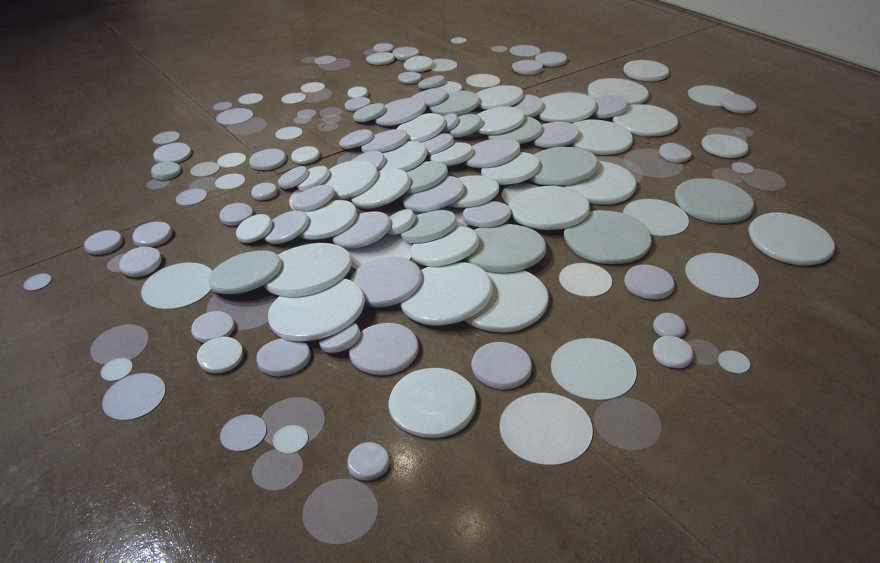
The Landscape of Perception
Paula Crawford, artist and critic
It has been said that painting can elongate time, by registering the many moments that it takes the painter to observe and record the object of observation. Thus, a painted landscape can be seen as a rich and compressed documentary of the many times of day and weather patterns experienced by the artist over the many hours or day required for a work’s completion. The result is a complexity particular to painting, an array of the often conflicting patterns and expressions that culminate in a whole, which may indeed seem larger than the summation of its parts. The photographic snapshot, on the other hand, captures an instant. A split second when the object of observation is caught, and forever frozen. If the space of painting can be charted on a synchronic axis, imbued with the shifting poetics and echoes of its
own signification, the space of photography is confined to being a point (or still) on the horizontal axis of time. Marisa Tellería-Díez, in an exhibition at Fusebox in Washington, DC, has forced an opening for photography into the painter’s domain by prying open a space between view and viewer, and then occupying it, with a series of perceptual deferrals.
The exhibition contains photographs, a video installation, and several sculptural forms, which bracket and punctuate the gallery space. The photographs, grouped and then positioned at regular intervals, appear initially to be vague color-field abstractions. But a seductive recognizibility, along with parentheticals in the titles that point to location or substance, invite the viewer to re-perceive the images as natural forms, landscapes even.
Before examining Tellería-Díez’s relocation of landscape into perceptive space, it is worth looking, for a moment, at landscape, not as reflective of an original referent but rather as representation of an idea. In her essay The Originality of the Avant-Garde: A Postmodernist Repetition, Rosalind Krauss invokes the description of a 19th century English country walk in Jane Austen’s novel Northanger Abbey. In the scene, a local reverend and his son evaluate the suitability of various vistas for artistic rendering, on the basis of their endowments of certain ‘natural’ qualities, which represent collectively held notions of the picturesque. In essence, they judge nature on the basis of its suitability to stand in for a pre-existing mental (and linguistic) construction of an idea, landscape. And so, Krauss argues, “landscape becomes a reduplication of a picture which preceded it.” The stock Platonic idea that nature itself is condemned to being a representation, is reasserted by Krauss as a poststructuralist paradigm, where a whole chain of deferrals from signification inevitably point the viewer away from the place of meaning.
Here, where nature is constructed as the representation of its own absence, Tellería-Díez begins her investigations. For the series of color photographs displayed at Fusebox, Tellería-Díez took close-ups of sky, water, sand or algae, formatted them into squares, and bonded the images to plexiglass panels, which were then set away from the wall. By zooming in with a telescopic lens to one small fragment of a putative whole, the artist has shifted the landscape away from its iconic identity within its own tradition and into the space of abstraction. As its linguistic and historical identifiers begin to evaporate, so to do the inevitable references to landscape, leaving a precarious image that seems to reside in the flickering space between signification and the attempted refusal of it. The final inversion is the reification of the image into object as completed by its permanent assignment to the plexiglass panel, reconstituting the image into its own framing devise. Thus the artist, in her understated way, points the viewer away from the object itself, and to a kind of perceptual space that veils it.
If the photographic panels, on some level, convert image into object, the sculptural forms, which punctuate the gallery space, spill back into the territory of image. Constructed out of fiberglass and hydrocal, they are painted with the meticulousness of a Bierstadt, while evoking a range of associations from Carl Andre’s Scatter Pieces to Artschwager’s Blps to Piero Gilardi’s Tapeti natura. White and smooth, like riverstones (or microbes), they gather in order formations, at once occupying and dividing the architectural space that contains them. Carefully painted in the front, with high-key and low-contrast horizontal zones, the back of each form reflects a glowing sky blue that creates a light effect upon the form behind it. Thus, the classical vocabulary of landscape painting – shadow, modeling, light effects – is employed to veil the very physicality elicited by the form’s material identity as sculpture. Here the material referent, reproduces the relation Krauss observed between a real landscape as a signifier of an idea that precedes it and its representation in art.
The third area of investigation on a small video screen, installed flush to the wall in a corner of the gallery. MIA-JFK, an 8 minute 31 second looped video of sky footage, taken from an airplane window, as the artist traveled between Miami and New York, is another parable against the double reification of perceptive experience into viewer/object. Neither taking off nor landing, the moving images reside completely in the between spaces, bracketed by time. Unlike Jean-Marie Straub and Danièle Huillet’s motorcycle ride through Rome, where an attached camera records in a single shot a real-time journey from point A to B, MIA-JFK invites us to experience a dotted-line of separate real times without a beginning or end. Instead of a journey marked by different landscapes, as in the artist’s photographic panels, MIA-JFK conjures up a monotonous series of sky views located within a set of conceptual parentheses.
If an image of nature or otherwise can only reside in the moment of our perception of it, Marisa Tellería-Díez shifts the focus from the instantaneous consumption of an image to an argument for the impossibility of such consumption. She offers a universe of endless deferrals away from the place of meaning to the between space where the act of perception is always begun but never completed.
– Paula Crawford, artist and critic
Washington, DC, 2003.
TRANSITIONIG, Notes on Solo exhibition at Fusebox gallery
MarisaBela Tellería
Interior vs exterior up until now, I had found sources of meaning in my immediate surroundings, where the sense of place was expressed in the context of interior spaces, particularly in the relationship between domestic objects and the body. My current focus on exterior environments springs from a need to flnd meaning beyond the insularity of interior spaces and defne a broader sense of place. It was also an effort to widen my own means of expression by bringing more life into art and to strike a more personal tone in the work. The metaphorical references to my personal history, more than pointing to the biographical, serve to provide context for questions of visual perception. To explore how the exchange between self and place is constituted, and how the fillters we accumulate from place to place affect our perception of things.
Shifting scale working on a smaller scale responds to a need to recover the strength and freshness behind the “non-heroic” gestures of smaller work. In previous room size installations and other large scale 3-d works, immediacy and spontaneity were often buried under layers of labor-intensive processes .Here, I wanted to make work that speaks less of its own making, and that suggests an elusive quality beyond its “objectness”. Small objects and images capable of occupying immense spaces mentally, psychologically. Yet, rather than engufing viewers in the space all at once, overtaking their consciousness and prescribing the terms of engagement with the work, this work invites viewers in for closer observation, allowing them to gradually discover the work at their own pace. It leaves it up to them to determine their proximity to the work based on their own sense of “personal space.”
Attenuating the sign in keeping with my interest in prolonging the moment between observation and recognition, this work seeks to detach objects from the imagery by which we too- quickly recognize the familiar. The intention is for labels and signs to recede, allowing the viewer to experience the essence of the thing more purely, at a sensorial level, unhindered by concepts. The aim is not to provide an accurate representation of the thing, place or event, but to distill them to sensations – to that which clings to the body and persists through time and distance.
Erasing the medium consistent with previous efforts to cross-reference media, the choice to go beyond studio- based processes and introduce photography and video as a complement to 3-d work coincided with the need to recover spontaneity and immediacy. The intention was not to showcase the possibilities of each medium, but in fact to transcend their materiality and erase the boundaries between them. Each piece speaking with its own voice, yet resonating with each other, across media, beyond formal considerations.
Opposites (still) coexisting while the sculptures and photographs speak of a sense of place, the video alludes to a space between places,neither here nor there. To a non- place.—
It introduces movement, yet it alludes to the stillness of the moment, to a static movement. To the barely perceptible passage of time. The dialogue between the tactile and the atmospheric echoes from piece to piece. Video, photographs, and sculptures, existing between flatness and depth, opacity and luminosity, density and airiness, object and image. Pointing not to the grandiose, but to the immensity of small moments.
About process
The 3-d objects in these installations were fabricated (not cast) from laminated sheets of styrofoam, carved, and covered with fiberglass and several layers of hydrocal, each layer finely sanded. Some were painted, and others were coated with flocking material. The color photographs were made from original 35mm and medium format transparencies printed digitally using an archival pigment inkjet process and mounted on board with non-glare plexiglas. The video was shot on digital video, transferred to dvd, and rear projected onto a fabricated wall with a 7” x 10” opening.